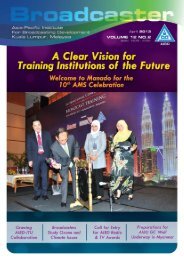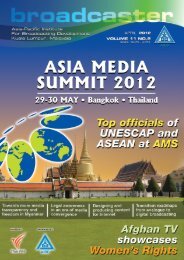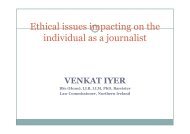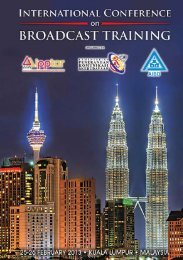SUMMIT
New Visions Asia Media Summit 2008 - AIBD
New Visions Asia Media Summit 2008 - AIBD
- No tags were found...
Create successful ePaper yourself
Turn your PDF publications into a flip-book with our unique Google optimized e-Paper software.
Third, efforts need to be made to guide public senment. The correct coverage of the<br />
media can help allay public fears, rally social resources, and effecvely tackle crises. While<br />
providing informaon through the main channels, media organisaons should parcularly<br />
pay aenon to the spread of rumors and “hearsays”, put the scope and channels of<br />
rumor spread under control and undo the damages they have inflicted.<br />
Fourth, the media needs to make utmost efforts to affect the decision making of the<br />
government and the implementaon of such decisions. Media organisaons need to<br />
provide mely reports to the government on the development of the crisis and the<br />
psychological state of the public and help the government make scienfic decisions. Once<br />
the decisions are published, media organisaons also have the obligaon to publicize such<br />
decisions for the government so as to set the stage for the following implementaon of<br />
the decisions.<br />
Last but not least, the media also needs to help the government form a posive image.<br />
The mely media coverage of the steps taken by the government to handle crisis and the<br />
effects of such measures plays a crucial role in shaping the image of the government.<br />
In early 2008, many provinces and cies in southern China were devastated by a serious<br />
snow storm; on 12 May, a strong earthquake measuring 8.0 Richter scale struck China’s<br />
Wenchuan County and the post-disaster rescue and reconstrucon are sll underway. In<br />
the wake of the two crises, China’s mainstream media represented by CCTV immediately<br />
passed on the latest development of the disaster to the public in an accurate, mely,<br />
comprehensive and transparent manner and provided prompt coverage on the<br />
government’s disaster relief efforts. In the aermath of the earthquake, the live coverage<br />
of CCTV became the primary source of informaon for the general public, the government<br />
and domesc and foreign media organisaons. For example, most of the viewers received<br />
the latest developments of the disaster from the live footage of CCTV; CCTV live news<br />
programmes were aired in the disaster relief headquarters in the affected areas; CNN,<br />
ABC, BBC, NHK and many other world-renowned media organisaons also relayed CCTV’s<br />
reports. Many famous overseas media organisaons even placed CCTV’s prompt, accurate<br />
and transparent coverage of the earthquake on a par with the disaster relief efforts of the<br />
Chinese Government.<br />
It fully shows that in the wake of crisis, as long as we can fully acvate the “environment<br />
monitoring” funcon of the media, reach the crisis scene immediately, gather informaon<br />
from all sources and set an effecve media agenda, we will be able to put media agenda,<br />
government agenda and public agenda under the same umbrella. It also demonstrates<br />
that in conngent incidents, only by acng in the public interests in our reporng can we<br />
achieve the opmal results we wish to deliver through our media agenda.<br />
Globalisaon is now gathering momentum economically, culturally and in many other<br />
fields as well. However, the globalisaon of informaon disseminaon is the driving force<br />
behind all these changes.<br />
79








